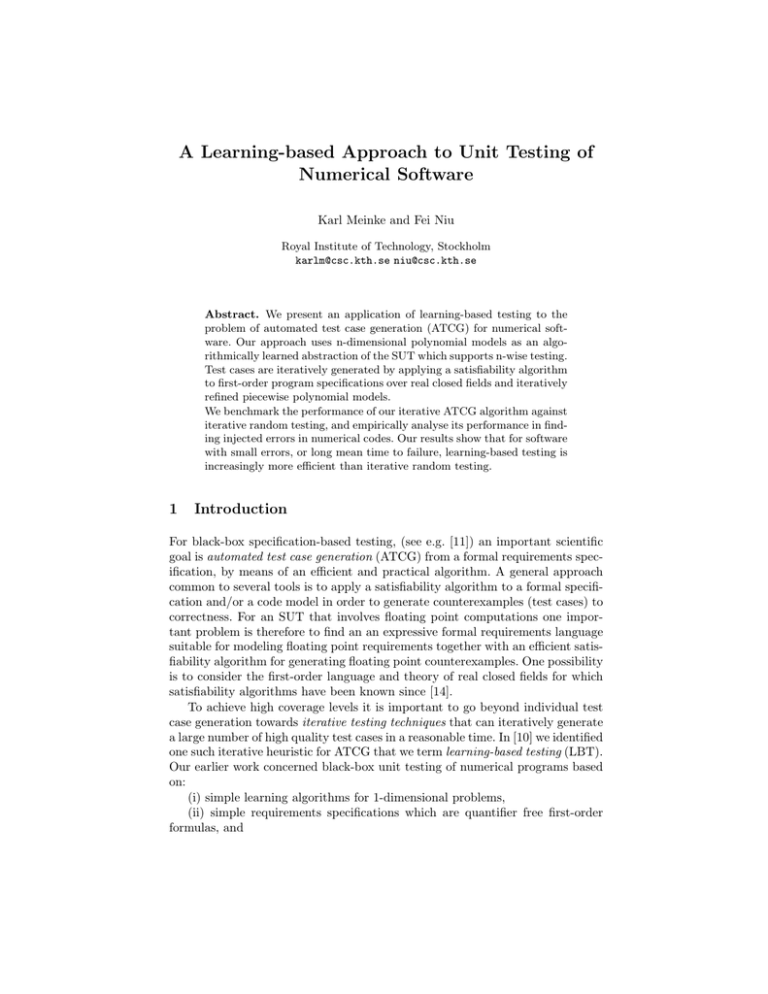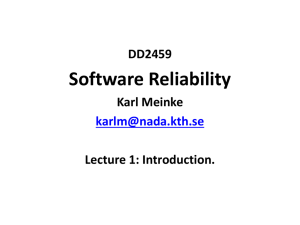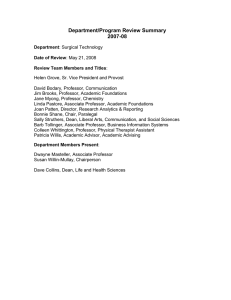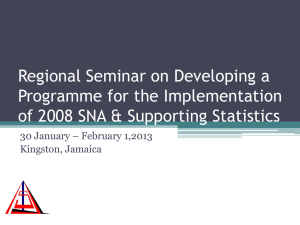A Learning-based Approach to Unit Testing of Numerical
advertisement

A Learning-based Approach to Unit Testing of
Numerical Software
Karl Meinke and Fei Niu
Royal Institute of Technology, Stockholm
karlm@csc.kth.se niu@csc.kth.se
Abstract. We present an application of learning-based testing to the
problem of automated test case generation (ATCG) for numerical software. Our approach uses n-dimensional polynomial models as an algorithmically learned abstraction of the SUT which supports n-wise testing.
Test cases are iteratively generated by applying a satisfiability algorithm
to first-order program specifications over real closed fields and iteratively
refined piecewise polynomial models.
We benchmark the performance of our iterative ATCG algorithm against
iterative random testing, and empirically analyse its performance in finding injected errors in numerical codes. Our results show that for software
with small errors, or long mean time to failure, learning-based testing is
increasingly more efficient than iterative random testing.
1
Introduction
For black-box specification-based testing, (see e.g. [11]) an important scientific
goal is automated test case generation (ATCG) from a formal requirements specification, by means of an efficient and practical algorithm. A general approach
common to several tools is to apply a satisfiability algorithm to a formal specification and/or a code model in order to generate counterexamples (test cases) to
correctness. For an SUT that involves floating point computations one important problem is therefore to find an an expressive formal requirements language
suitable for modeling floating point requirements together with an efficient satisfiability algorithm for generating floating point counterexamples. One possibility
is to consider the first-order language and theory of real closed fields for which
satisfiability algorithms have been known since [14].
To achieve high coverage levels it is important to go beyond individual test
case generation towards iterative testing techniques that can iteratively generate
a large number of high quality test cases in a reasonable time. In [10] we identified
one such iterative heuristic for ATCG that we term learning-based testing (LBT).
Our earlier work concerned black-box unit testing of numerical programs based
on:
(i) simple learning algorithms for 1-dimensional problems,
(ii) simple requirements specifications which are quantifier free first-order
formulas, and
(iii) an elementary satisfiability algorithm based on algebraic root solving for
cubic 1-dimensional polynomials.
In this paper we present a systematic and more powerful extension of LBT
that is suitable for black-box testing of complex numerical software units, including high-dimensional problems by means of n-wise (e.g. pairwise) testing. We
apply n-dimensional polynomial learned models that can support n-wise testing
and thus tackle the dimensionality problem associated with software units. We
generalise our previous learning algorithm to support n-dimensional piecewise
polynomial models using non-gridded data. This step also tackles the dimensionality problem on the SUT level. Finally, we use the Hoon-Collins cylindric algebraic decomposition (CAD) algorithm for satisfiability testing (see e.g. [1]). This
is a powerful satisfiability algorithm for first order formulas over the language
of real closed fields. Thus we greatly expand the complexity of the requirements
specifications that our tool can deal with.
It is natural to question the achieved quality of the test cases generated
by any new TCG method. In the absence of a theoretical model of efficiency,
we have benchmarked the quality of our learning-based ATCG empirically, by
comparing its performance with that of an iterative random test case generator.
This was the only other iterative ATCG method for floating point computations
to which we had any access. Since iterative random testing (IRT) is closely
related to measures of mean time to failure (MTF), our benchmarking results
have a natural and intuitive interpretation.
To carry out this performance comparison systematically, it was necessary
to avoid the experimental bias of focussing on just a small number of specific
SUTs and specific requirements specifications. To generate the largest possible
amount of comparative data we automated the synthesis of a large number of
numerical SUTs, their black-box specifications and their mutations. In this way
we compared the performance of learning-based and iterative random testing
over tens of thousands of case studies. Our average case results over this data set
demonstrate that when mutated errors have small effects (or equivalently when
the MTF of the mutated SUT is long) then learning based testing is increasingly
superior to random testing.
The structure of this paper is as follows. In Section 1.1 we review some related approaches to unit testing of numerical software and ATCG, found in the
literature. In Section 2, we discuss the general principles of learning-based testing. In Section 3, we present our learning-based testing algorithm for numerical
programs. In Section 4, we describe our evaluation technique, and present the
results of evaluation. In Section 5 we draw some conclusions from our work.
1.1
Related Work
There are two fields of scientific research that are closely related to our own.
On the one hand there is a small and older body of research on TCG for scientific computations. On the other hand, there is a more recent growing body
of research on ATCG methods obtained by combining satisfiability algorithms
with computational learning. Finally, there is an extensive mathematical theory
of polynomial approximation, see for example [12].
Unit Testing for Scientific Software It is widely recognised that the problem of testing scientific software has received relatively little attention in the
literature on testing. The existing literature seems focussed either on manual
techniques for TCG, or ATCG for individual test cases. Besides iterative random testing, we are not aware of any other approach to iterative ATCG for
numerical programs.
The intrinsic unreliability of many existing libraries of scientific code for the
earth sciences has been empirically studied at length in [6] and [7], which cite
static error rates in commercial code of between 0.6% and 20% depending upon
the type of program error.
The correctness of scientific library codes for metrology is considered in [4].
Here the authors consider black-box unit testing of well specified computations
such as arithmetic mean and deviation, straight-line and polynomial regression.
They apply 1-wise testing where all fixed parameter values and one variable parameter value are chosen from sets of reference data points that are manually
constructed to span a given input profile. Reference values are then algorithmically computed using numerical codes which the authors posit as providing
reliable benchmarks. The actual outputs produced by the SUT are compared
with these reference values using a composite performance measure. This measure is more sophisticated than an individual error bound as it can account for
the degree of difficulty of the chosen reference data set. The approach seems
more oriented towards measuring overall code quality while our own approach
focusses on finding individual coding errors quickly. Nevertheless, [4] successfully
highlights problems of numerical stability occurring in a variety of well known
scientific libraries and packages including NAG, IMSL, Microsoft Excel, LabVIEW and Matlab, thus confirming the real problem of correctness even among
simple and widely used scientific codes.
The method of manufactured solutions (MMS) presented in [13] provides a
theoretically well-founded and rigorous approach for generating a finite set of
test cases with which to test a numerical solver for a PDE (usually non-linear).
The test cases are constructed by analysis of the underlying mathematical model
as a non-linear system operator L[u(x, y, z, t)] to produce a finite set of analytical solutions for different input parameter values. Like our own approach
(but unlike [4]) MMS does not make use of any benchmark or reference codes
for producing test cases. This method is shown to be effective at discovering
order-of-accuracy errors in fault injected codes in [8]. The main weakness of
MMS is its restriction to a specific class of numerical programs (PDE solvers).
By contrast, the generality of our requirements language (first-order logic) and
our modeling technique (piecewise polynomials) means that by general results
such as the Weierstrass Approximation Theorem, we can perform ATCG for a
much larger class of programs and requirements.
ATCG using Computational Learning Within the field of verification and
testing for reactive systems, the existence of efficient satisfiability algorithms for
automata and temporal logic (known as model checkers) has made it feasible to
apply computational learning to ATCG using similar principles to our own. This
approach is known as counterexample guided abstraction refinement (CEGAR).
Some important contributions include [3], [2] and [5]. The basic principles of
CEGAR are similar to those we outline in Section 2, though our own research
emphasizes incremental learning algorithms and related convergence measures
on models both to guide model construction and to yield abstract black-box
coverage measures. While existing research on CEGAR emphasizes reactive systems, temporal logic and discrete data types, our work presented here considers
procedural systems, first order logic and continuous (floating point) data types.
However, the success of CEGAR research strongly suggests to generalize this
approach to other models of computation, and our work can be seen as such a
generalization.
2
Learning-based Testing
The paradigm for ATCG that we term learning-based testing is based on three
components:
(1) a (black-box) system under test (SUT) S,
(2) a formal requirements specification Req for S, and
(3) a learned model M of S.
Now (1) and (2) are common to all specification-based testing, and it is really
(3) that is distinctive. Learning-based approaches are heuristic iterative methods
to search for and automatically generate a sequence of test cases until either
an SUT error is found or a decision is made to terminate testing. The heuristic
approach is based on learning a black-box system using tests as queries.
A learning-based testing algorithm should iterate the following five steps:
(Step 1) Suppose that n test case inputs i1 , . . . , in have been executed on S
yielding the system outputs o1 , . . . , on . The n input/output pairs (i1 , o1 ), . . . ,
(in , on ) can be synthesized into a learned model Mn of S using an incremental
learning algorithm. Importantly, this synthesis step involves a process of generalization from the data, which usually represents an incomplete description of
S. Generalization gives the possibility to predict as yet unseen errors within S
during Step 2.
(Step 2) The system requirements Req are satisfiability checked against the
learned model Mn derived in Step 1. This process searches for counterexamples to the requirements.
(Step 3) If several counterexamples are found in Step 2 then the most suitable
candidate is chosen as the next test case input in+1 . One can for example attempt
to identify the most credible candidate using theories of model convergence (see
Section 3.3) or approximate learning.
(Step 4) The test case in+1 is executed on S, and if S terminates then the output
on+1 is obtained. If S fails this test case (i.e. the pair (in+1 , on+1 ) does not
satisfy Req) then in+1 was a true negative and we proceed to Step 5. Otherwise
S passes the test case in+1 so the model Mn was inaccurate, and in+1 was a
false negative. In this latter case, the effort of executing S on in+1 is not wasted.
We return to Step 1 and apply the learning algorithm once again to n + 1 pairs
(i1 , o1 ), . . . , (in+1 , on+1 ) to synthesize a refined model Mn+1 of S.
(Step 5) We terminate with a true negative test case (in+1 , on+1 ) for S.
Thus an LBT algorithm iterates Steps 1 . . . 4 until an SUT error is found
(Step 5) or execution is terminated. Possible criteria for termination include a
bound on the maximum testing time, or a bound on the maximum number of
test cases to be executed. From the point of view of abstract black-box coverage,
an interesting termination criterion is to choose a minimum value for the convergence degree dn of the model Mn as measured by the difference |Mn | − |Mn−1 |,
according to some norm |.| on models. We can then terminate when Mn achieves
this convergence degree.
This iterative approach to TCG yields a sequence of increasingly accurate
models M0 , M1 , M2 , . . ., of S. (We can take M0 to be a minimal or even empty
model.) So, with increasing values of n, it becomes more and more likely that
satisfiability checking in Step 2 will produce a true negative if one exists. Notice
if Step 2 does not produce any counterexamples at all then to proceed with the
iteration, we must construct the next test case in+1 by some other method, e.g.
randomly.
3
Algorithm Description
In this section we show how the general framework of learning-based testing,
described in Section 2, can be instantiated by: (i) piecewise polynomial models Mi , (ii) incremental learning algorithms, and (iii) an implementation of the
CAD algorithm in MathematicaTM , used as a satisfiability checker. The resulting
learning-based ATCG can be used to automatically unit test numerical programs
against their requirements specifications expressed as first order formulas over
the language of real closed fields.
3.1
Piecewise Polynomial Models
The learned models Mi that we use consist of a set of overlapping local models,
where each local model is an n-dimensional and d-degree polynomial defined over
an n-dimensional sphere of radius r over the input/output space. Since (d + 1)n
points suffice to uniquely determine an n-dimensional degree d polynomial, each
local model has (d + 1)n such points. One such point c ∈ Rn is distinguished as
the centre point. The radius r of a local model is the maximum of the Euclidean
distances from the centre point to each other point in that model. Figure 1
illustrates this for the simple case n = 1 and two overlapping 1-dimensional
cubic polynomial models of degree 3. With n-dimensional polynomials we can
automate n-wise testing, e.g. for n = 2 we obtain pairwise testing. Concretely, a
model Mi is represented as an array of LocalModel objects.
y
10
Overlapping Area
r1
5
f1 HxL
f2 HxL
-5
5
10
15
x
r2
-5
Centre Points
Fig. 1. Two cubic local models fi (x) = ai x3 + bi x2 + ci x + di , i = 1, 2
We use a non-gridded approach to selecting the centre point for each local
model. This means that the centre point c can take any value x ∈ Rn and is not
constrained to lie on a vertex of an n-dimensional grid of any specific mesh size.
Non-gridded modeling helps avoid an exponential blowup in the number of grid
vertex points as the model dimension n increases. It also allows us to choose test
case values with complete freedom. So test cases can cluster densely within areas
of suspected errors, and sparsely within areas of likely correct behavior. This is
one reason why LBT exceeds the performance of iterative random testing since
the latter uniformly samples the search space of test cases.
3.2
A Learning-based Testing Algorithm
We now give a concrete instantiation of the abstract learning-based ATCG, outlined in Section 2, for numerical programs. This combines incremental learning
methods for the piecewise polynomial models described in Section 3.1 together
with an implementation of the CAD algorithm for satisfiability checking such
polynomial models against requirements specifications. As is usual for procedural programs, a requirements specification for a numerical program S under test
is expressed as a Hoare triple (see e.g. [9])
{pre}S{post},
where the precondition pre and postcondition post are first order formulas over
the language of real closed fields. Thus pre and post describe constraints on the
input and output floating point variables of S at the start and end of computation. A true negative (or failed) test case is any test case which satisfies the
triple {pre}S{¬post} under the usual partial correctness interpretation of Hoare
triples. Our algorithm automatically searches for at least one true negative test
case where S terminates. (We handle non-termination, should it arise, with a
simple time-out.) This approach is easily extended to multiple negatives if these
are required.
Before satisfiability checking can be applied, it is necessary to have at least
one local polynomial model. Therefore the ATCG procedure given in Algorithm
1 below is divided into an initialisation phase and a learning-based phase. During
the initialisation phase (lines 1-10), the minimum number (d + 1)n of test cases
necessary to build one local model, is randomly generated (line 4). Each such
test case t is executed on the SUT S and the output is stored (line 6). During the
iterative learning-based phase (lines 11-30), on each iteration we try to generate a
new test case either through: (i) performing satisfiability checking on the learned
model (line 16) or, (ii) random test case generation (line 22). Whenever a new
test case is generated and executed, the result is added to the model (line 26).
Then the local models nearest the test case are updated and refined using this
test case (line 28).
Note that Algorithm 1 makes two API calls to the Mathematica kernel1 .
Line 16 of Algorithm 1 makes a call to the Mathematica kernel in order to
satisfiability check the formula pre ∧ ¬post against the local model m, for each of
the C best converged local models. The kernel function FindInstance(. . . ) is the
Mathematica implementation of the Hoon-Collins CAD algorithm. If a satisfying
variable assignment to pre ∧ ¬post over m exists then this kernel call returns
such a variable assignment. In the case that no counterexample is found among
the C best converged local models, then line 22 of Algorithm 1 makes a call
FindInstance(M[random()], pre) to the same kernel function to find a satisfying
variable assignment over a randomly chosen local model for precondition pre.
As shown in Algorithm 1, an array M of LocalModel objects is maintained.
We use M [i] for 0 ≤ i < length(M ) to denote the i-th element of M and M [i : j]
for 0 ≤ i ≤ j < length(M ) to refer to the subinterval of M between i and j − 1,
inclusive.
3.3
Learning Local Models
The two subprocedures LearnModel and UpdateModels called in Algorithm 1 are
detailed in Algorithms 2 and 3. These implement a simple incremental learning
method along the general lines described in Step 1 of Section 2. Algorithm LearnModel infers one new local model using the newly executed test case t on the
SUT. We use a simple linear parameter estimation method in line 6. The use
of more powerful non-linear estimation methods here is an important topic of
future research. Algorithm UpdateModels updates all the other existing local
models using t and sorts the C best converged models.
In Algorithm 2 (line 6), model learning is performed using a linear parameter
estimation method. The Mathematica kernel function LinearSolve(c, b) is used
to find a vector of (d + 1)n coefficients satisfying the matrix equation c · x =
1
We use MathematicaTM version 7.0 running on a Linux platform.
Algorithm 1: Learning-BasedTesting
Input:
1. S(t : T estCase) - the SUT expressed as a function
2. pre, post - pre and postcondition for the SUT
3. d : int - the maximum approximation degree of poly
4. max : int - the maximum number of tests
5. C : int - the maximum number of model checks for each test
Output: ErrorFound or TimeOut if no error was found
1
2
3
4
5
6
7
8
9
10
11
12
13
14
15
16
17
18
19
20
21
22
23
24
25
26
27
28
29
30
// Initialisation phase
T, M ← ∅ // Initialise set T of test cases and array M of models
n ← input dimension of S
support size ← pow(d + 1, n)
T ← set of support size randomly generated test cases
foreach t in T do
t.output ← S(t) // run S on t
if t violates post then
return ErrorFound + t.toString()
foreach TestCase t in T do
M.add(LearnModel(T, t, support size))
// Learning-based phase
count ← 0
while count < max do
t ← null
for i ← 0 to min(C, length(M)) do
m ← M [i]
t ← FindInstance (m, pre ∧ ¬post)
if m.converg < then
// Delete converged local model
M.delete(m)
if t is NOT null then
break
if t is null then
t ← FindInstance (M [random()], pre)
t.output ← S(t) // run S on t
if t violates post then
return ErrorFound + t.toString()
M.add(LearnModel(T, t, support size)) // cf. Algorithm 2
T.add(t)
M ← UpdateModels(M, t, support size, C) // cf. Algorithm 3
count ← count + 1
return TimeOut
b, for the approximating d degree polynomial function in n variables. Note, if
the call to LinearSolve fails, then temporarily we have no local model around
m.centreP oint, but this can be corrected later by calls to Algorithm 3. Also
note in Algorithm 2 that without any previous model history, we are not yet
able to compute the convergence value of a newly constructed local model (as
we do in Algorithm 3). Hence convergence is initialized to 0.0 (line 7). This forces
the new local model to have the minimum possible convergence value, so it has
the possibility to be satisfiability checked during the learning-based phase even
though its convergence value is undefined.
In Algorithm 3, when updating a local model, a Monte-Carlo method (lines
6, 7) is used to efficiently approximate the convergence value obtained using the
integral norm L1 on bounded polynomials. Each time local models are updated,
the first C best converged local models are randomly swapped to the first C
positions of the array M, provided C is greater than or equal to the length of
M (line 10, 11). This, together with line 14 in Algorithm 1, implements the
prioritisation Step 3 of the abstract LBT algorithm of Section 2. In practice,
the value of C is empirically determined. A higher value of C can probably take
better advantage of model checking while it slows down the speed of learningbased testing if model checking is time consuming.
Algorithm 2: LearnModel
Input:
1. T - the set of all executed test cases
2. t : T estCase - a newly executed test case
3. support size : int - the number of test cases needed to build one local
polynomial model
Output: a new local model with centre t
1
2
3
4
5
6
7
8
4
4.1
m ← new LocalM odel()
m.centreP oint ← t
m.localP oints ← from T pick support size test cases nearest to t
m.radius ← maximum Euclidean distance between t and each data point
of m.localP oints
Form the matrix equation c · x = b from m.localP oints
m.poly ← LinearSolve(c, b)
m.converg ← 0.0
return m
Experimental Evaluation
Construction of SUTs, Specifications and Mutations
We wished to benchmark the performance of LBT against another iterative
ATCG method for floating point computations. The simplest and most obvious
Algorithm 3: UpdateModels
Input:
1. M - array of all local models obtained so far
2. t : T estCase - a newly executed test case
3. support size : int - cf. Algorithm 2
4. C : int - cf. Algorithm 1
1
2
3
4
5
6
7
8
9
10
11
12
13
14
foreach LocalModel m in M do
if t inside m then
T ← m.localP oints.add(t)
t̂ ← m.centreP oint
m̂ ← LearnModel(T, t̂, support size)
randomly pick P
N test cases t1 , t2 , . . . tN
|m.poly(ti )−m̂.poly(ti )|
m̂.converg ← i=1,...,N
N
m ← m̂
if C < length(M ) then
Partially sort M to ensure M [0 : C] are linearly ordered by convergence
Randomly permute M [0 : C]
else
Randomly permute M
return M
candidate for comparison was iterative random testing, which is fairly easy to
implement when requirements specifications are simple. This comparison has the
advantage that iterative random testing can be viewed as a Monte Carlo method
to estimate the mean time to failure (MTF) of an SUT over an equiprobable
distribution of input values. Our experiments confirmed that this estimated MTF
value was inversely proportional to the size of injected mutation errors, as one
would expect.
In order to obtain the largest possible data set of performance results, we
used random generators to construct the numerical SUTs, their first-order logic
specifications and their mutations. These also allowed us to perform experiments
in a controlled way, in order to more accurately assess factors that influence the
performance of our ATCG. The random numerical program generator (RPG)
and specification generator (SG) were used to generate hundreds of SUTs with
their specifications and introduce thousands of mutations. Iterative random testing was also repeated hundreds or thousands of times on each SUT, until the
estimated MTF value appeared well converged.
Random Numerical Program Generation (RPG) To randomly generate a numerical program as an SUT, the RPG divides a global n-dimensional
input space into subspaces at random. Within each of these randomly chosen
subspaces, the RPG generates an n-dimensional polynomial surface of random
shape (i.e. coefficients) and degree. We allowed for much higher degrees in such
SUT models than in the learned models of Section 3.1 in order to ensure that the
learning problem would be non-trivial. When a random SUT was generated, we
then mutated it randomly to inject faults by changing the shapes or positions of
the polynomial surfaces in one or more subspaces. Figure 2 gives an example of
a randomly generated SUT for one dimensional input and six randomly chosen
subspaces. To mutate the SUT, we simply regenerate different curves over some
of the same subspaces, and this is also shown in Figure 2. The ratio of the total
size of the mutated subspaces to the total size of all subspaces represents the
percentage error size. Controlling this percentage error size experimentally, was
the key to understanding the relative performance of LBT and iterative random
testing. For example in Figure 2, the percentage error size is 50%.
3000
2500
2000
1500
1000
500
mutation
50
mutation
100
150
200
Fig. 2. A randomly generated SUT: 6 subspaces of which 2 are mutated
Random Specification Generation (SG) Since for evaluation purposes a
large number of SUTs were automatically randomly generated, it was necessary
to automatically generate their requirements specifications too. At the same
time it was necessary to ensure that the requirement generated for each SUT
was semantically correct in its unmutated state. It is well known (see [1]) that
the logical complexity of requirements formulas has an effect on the efficiency
of satisfiability checking, and hence on LBT as a whole. To explore the effects
of this complexity, we studied the relative performance of LBT and IRT against
two different logical types of requirements specifications.
Let S be a randomly generated SUT with k subspaces and 1-dimensional
input S = f1 (x), f2 (x), . . . , fk (x). Then for both types of requirements specifications, the same precondition was used. We call this an interval bound precondition on the input variable x of the form
pre(S) ≡ c1 ≤ x ≤ ck+1 .
Here the input interval [c1 , ck+1 ] for an SUT is divided into k subintervals
[ci , ci+1 ] for 1 ≤ i ≤ k by the boundary values c1 , c2 , . . . , ck , and fi (x) describes
the behaviour of S over the i-th subinterval [ci , ci+1 ].
On the other hand two different types of postconditions could be generated:
we call these equational and inequational postconditions.
For the same SUT S, its equational postcondition is a formula of the form:
^
eq post(S) ≡
( ci ≤ x < ci+1 ⇒ kfi (x) − mi (x)k < )
i=1,...,k
where mi (x) describes the mutation of fi (x) (if any) over the i-th subinterval.
Intuitively, eq post(S) asserts that the function of the mutated SUT is equal to
the function of the original SUT S, to within an absolute tolerance .
The inequational postcondition for S is a formula of the form:
^
ineq post(S) ≡
( lower bound < fi (x) )
i=1,...,k
Intuitively, ineq post(S) asserts that all values of each function fi (x) lie above
a constant lower bound. The value of lower bound is randomly chosen so that
this postcondition is semantically correct for the unmutated (correct) program
S.
These preconditions and two types of postcondition generalise in an obvious
way to n-dimensional input for n ≥ 2.
4.2
Results and Analysis
Having set up random generators for numerical programs and their specifications, we proceeded to generate a large number of SUT/specification pairs, and
mutate these SUTs to achieve different percentage error sizes within the range
10% to 0.01%. We then measured the minimum number of test cases using LBT
and IRT needed to find the first true negative in each mutated SUT. This measurement was chosen since for IRT it provides an estimate of the mean time to
failure (MTF) of the mutated SUT under an equiprobable input distribution.
(We can view IRT as a Monte Carlo algorithm to estimate MTF.) To deal with
the stochastic behavior of IRT, this value was averaged out over many runs until
a well converged mean value had emerged. We then compared the ratio of these
two measurements, and averaged out this figure over many different SUTs and
many different mutations all of the same percentage error size. The results of
our experiments are given in Figure 3 which illustrates the relative performance
of LBT and IRT as the percentage error size is reduced. The x-axis expresses
the percentage error size (c.f. Section 4.1) on a logarithmic scale. The y-axis
gives the ratio IRT/LBT of the average number of IRT test cases divided by
the average number of LBT test cases. Note that Figure 3 shows two curves,
one for testing SUTs against equational specifications and one for testing SUTs
against inequational specifications. Also note that above an error size of 10%,
both curves converge rapidly to y = 1.0, which explains our chosen range of
error sizes.
The two distinct curves in Figure 3 clearly indicate that relative performance
of LBT is influenced by the logical complexity of specifications, as we expected.
However, the shapes of both curves are similar. Both curves show that as the
æ
Equational spec.
à
Inequational spec.
Performance ratio IRTLBT
14
à
12
à
10
8
æ
æ
6
à
4
æ
2
0.01
0.1
1
à
æ
æ
à
10
100
Error size H%L
Fig. 3. Relative performance of IRT and LBT
percentage error size decreases (or equivalently the MTF of the mutated SUT
increases) the efficiency of LBT over IRT increases. Since the x-axis is logarithmic, this improvement in relative performance seems approximately exponential
in the percentage size of errors.
4.3
A Concrete Case Study: Bubblesort
The statistical results of Section 4.2 may appear somewhat abstract, since the
thousands of randomly generated case studies do not correspond to specific well
known algorithms. Therefore, we complement this statistical analysis with a
concrete case study.
1
2
3
4
5
6
7
8
9
10
11
12
13
14
15
16
17
18
19
class BubbleSort {
public void sort(double[] a) {
for (int i = a.length; ­­i >= 0; ) {
boolean flipped = false;
for (int j = 0; j < i; j++ ) {
// Mutated from “if (a[j] > a[j+1]) {“
if (a[j] ­ N > a[j+1]) {
double T = a[j];
a[j] = a[j+1];
a[j+1] = T;
flipped = true;
}
}
if (!flipped) {
return;
}
}
}
}
Fig. 4. Bubblesort algorithm with mutation
Figure 4 presents the familiar Bubblesort algorithm for an array of floating
point numbers. This algorithm represents a typical high dimensional problem,
since the input (and hence output) array size is usually rather large. In line 7 we
introduce a mutation into the code via a parameter N . This particular mutation
was mainly chosen to evaluate the quality of test cases, since it allows us to
control the percentage error size of the mutation. Despite the high dimension of
this SUT computation, pairwise LBT testing can find the mutation error fairly
quickly. Figure 5 illustrates2 why this is so. Taking a 2-dimensional polynomial
model on any output array value, Figure 5(a) shows that the SUT itself can be
modeled quite easily. Furthermore Figure 5(b) shows that the mutated SUT can
also be modeled with just a little more effort, since large regions of this model
are again essentially simple. A suitable requirement specification for this code is
just to assert that the output array is linearly ordered:
{
a.length−1
^
M IN < a[i] < M AX} BubbleSort {
a.length−2
^
i=0
a[i] ≤ a[i + 1]}
i=0
where M IN and M AX are simply the lower and upper bounds of input values.
As in Section 4.2, we can measure the minimum number of test cases required
by LBT and IRT to find the first true negative in the mutated SUT, against the
above requirement specification. Our results show that on average (since IRT
has a stochastic performance) LBT is 10 times faster than IRT at uncovering
the mutation error.
a@0D
0
5
10
15
a@0D
20
0
10
15
20
20
20
a@.D 15
a@.D 15
10
5
10
20
20
15
15
10
10
a@1D
5
0
(a) Model segment of original SUT
a@1D
5
0
(b) Model segment of mutated SUT
Fig. 5. Modeling the Bubblesort algorithm with and without mutation
5
Conclusion
We have presented a systematic and powerful extension of the learning-based
testing (LBT) approach to iterative ATCG introduced in [10]. We have compared the performance of LBT against the results of iterative random testing
over a large number of case studies. Our results clearly demonstrate that LBT,
2
Note that the grid structure in Figures 5(a) and 5(b) is an artifact of the Mathematica graphics package, the models themselves are non-gridded.
while never worse than iterative random testing, can be significantly faster at discovering errors. Future research will also consider non-linear models and learning
algorithms for floating point data types. More generally, we also need to consider
the problem of learned models, learning algorithms and satisfiability checkers for
other data types besides floating point, in order to increase the range of applicability of our testing methods.
Acknowledgement
We gratefully acknowledge financial support for this research from the Chinese
Scholarship Council (CSC), the Swedish Research Council (VR) and the European Union under project HATS FP7-231620.
References
1. B. F. Caviness and J. R. Johnson. Quantifier Elimination and Cylindrical Algebraic
Decomposition. Springer Verlag, 1998.
2. Pankaj Chauhan, Edmund M. Clarke, James H. Kukula, Samir Sapra, Helmut
Veith, and Dong Wang. Automated abstraction refinement for model checking
large state spaces using sat based conflict analysis. In Proc. 14th International
Conference On Formal Methods in Computer-Aided Design (FMCAD02), 2002.
3. Edmund Clarke, Anubhav Gupta, James Kukula, and Ofer Strichman. Sat-based
abstraction refinement using ilp and machine learning. In Proc. 21st International
Conference On Computer Aided Verification (CAV’02), 2002.
4. M.G. Cox, P.M. Harris, E.G. Johnson, P.D. Kenward, and G.I. Parkin. Testing
the numerical correctness of software. Technical Report CMSC 34/04, National
Physical Laboratory, Teddington, January 2004.
5. A. Groce, D. Peled, and M. Yannakakis. Adaptive model checking. Logic Journal
of the IGPL, 14(5):729–744, 2006.
6. L. Hatton and A. Roberts. How accurate is scientific software? ACM Transactions
on Software Engineering, 20(10):786–797, 1994.
7. Les Hatton. The chimera of software quality. Computer, 40(8):104, 102–103, 2007.
8. P. Knupp and K. Salari. Verification of Computer Codes in Computational Science
and Engineering. CRC Press, 2002.
9. Jacques Loeckx and Kurt Sieber. The foundations of program verification (2nd
ed.). John Wiley & Sons, Inc., New York, NY, USA, 1987.
10. Karl Meinke. Automated black-box testing of functional correctness using function
approximation. In ISSTA ’04: Proceedings of the 2004 ACM SIGSOFT international symposium on Software testing and analysis, pages 143–153, New York, NY,
USA, 2004. ACM.
11. Robert M. Poston. Automating Specification-Based Software Testing. IEEE Computer Society Press, Los Alamitos, CA, USA, 1997.
12. M. Reimer. Multivariate Polynomial Approximation. Birkhauser Basel, October
2003.
13. P.J. Roache. Building pde codes to be verifiable and validatable. Computing in
Science and Engineering, pages 30–38, September/October 2004.
14. A. Tarski. Decision Method for Elementary Algebra and Geometry. Univ. of California Press, 1951.






